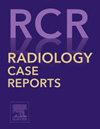Two cases of myeloid sarcoma of the mediastinum
Q4 Medicine
引用次数: 0
Abstract
Myeloid sarcoma is a malignancy characterized by the excessive proliferation of immature myeloid cells or myeloblasts, leading to tumor formation outside the bone marrow. This condition often manifests before or after the onset of acute myeloid leukemia or during a relapse following initial remission. Myeloid sarcoma develops in any organs or parts of the body, but its occurrence in the mediastinum is rare. We report 2 cases of myeloid sarcoma in the mediastinum. The first case was a 63-year-old woman who experienced exertional dyspnea and was found to have a mediastinal mass along with a left pleural effusion on computed tomography (CT). Blood tests revealed abnormal cells, and a diagnosis of acute myeloid leukemia was confirmed by a bone marrow examination. A CT-guided biopsy of the mediastinal mass confirmed myeloid sarcoma. The second case was a 43-year-old man who presented with dyspnea on exertion and was discovered to have a mediastinal mass compressing the trachea and bronchus on CT. Additionally, a soft tissue lesion with bone destruction in his left maxillary sinus was found on CT. His blood tests showed no abnormalities. Since the CT-guided biopsy of the mediastinal mass did not yield a definitive diagnosis, the second biopsy of the maxillary sinus lesion led to the diagnosis of myeloid sarcoma. It is crucial to consider myeloid sarcoma in the differential diagnosis of mediastinal tumors to facilitate early detection and treatment.
求助全文
约1分钟内获得全文
求助全文
来源期刊

Radiology Case Reports
Medicine-Radiology, Nuclear Medicine and Imaging
CiteScore
1.10
自引率
0.00%
发文量
1074
审稿时长
30 days
期刊介绍:
The content of this journal is exclusively case reports that feature diagnostic imaging. Categories in which case reports can be placed include the musculoskeletal system, spine, central nervous system, head and neck, cardiovascular, chest, gastrointestinal, genitourinary, multisystem, pediatric, emergency, women''s imaging, oncologic, normal variants, medical devices, foreign bodies, interventional radiology, nuclear medicine, molecular imaging, ultrasonography, imaging artifacts, forensic, anthropological, and medical-legal. Articles must be well-documented and include a review of the appropriate literature.
 求助内容:
求助内容: 应助结果提醒方式:
应助结果提醒方式:


